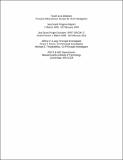| dc.contributor.author | Lang, Jeffrey H. | |
| dc.contributor.author | Hover, Franz S. | |
| dc.contributor.author | Triantafyllou, Michael S. | |
| dc.date.accessioned | 2015-05-14T18:01:39Z | |
| dc.date.available | 2015-05-14T18:01:39Z | |
| dc.date.issued | 2009 | |
| dc.identifier.uri | http://hdl.handle.net/1721.1/96999 | |
| dc.description.abstract | Inspired by the lateral-line organ in fish, the ultimate objective of this project continues to be the development of a passive system for AUVs that can detect, classify and locate underwater objects. The lateral line sensory organ in fish enables some species to form three-dimensional maps of their surroundings. The canal subsystem of that organ acts as an array of pressure sensors. Interpreting spatial pressure gradients allows fish to perform a variety of actions from schooling, to tracking prey, to recognizing nearby objects. Similarly, by measuring pressure variations on a vehicle surface, an engineered dense pressure-sensor array could enable the identification and location of obstacles during navigation. Our navigation system is based upon two key technologies: (1) large arrays of very small pressure sensors that can be mounted on the surface of an AUV, and (2) the pressure signal processing algorithms through which object detection, classification and location is implemented. Correspondingly, this project is organized during its early years around the development of these two key technologies. | en_US |
| dc.language.iso | en_US | en_US |
| dc.publisher | Massachusetts Institute of Technology. Sea Grant College Program | en_US |
| dc.relation.ispartofseries | MIT Sea Grant Technical Reports;MITSG 09-31 | |
| dc.title | Touch-at-a-Distance: Pressure Microsensor Arrays for AUV Navigation | en_US |
| dc.type | Technical Report | en_US |
